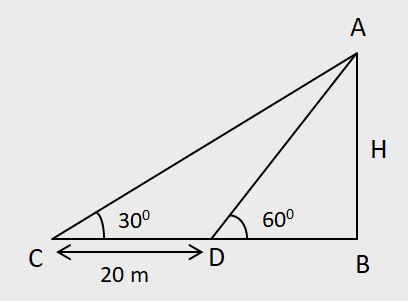|
A man wishes to find the height of a flagspost which stands on a horizontal plane, at a point on this plane he finds the angle of elevation of the top of the flagspost to be θ1. On walking 'z' units towards the tower he finds the corresponding angle of elevation to be θ2. Then the height (H) of the flagpost is given by
[
ztanθ1tanθ2
/
tanθ2 − tanθ1
] units and the value of DB(below given) is given by
ztanθ1
/
tanθ2 − tanθ1
units.

Note: The angle of elevation of a lampost changes from θ1 to θ2, when a man walks towards it. If the height of the lampost is H metres, then the distance travelled by man is given by
[
H(tanθ2 − tanθ1)
/
tanθ1 x tanθ2
] metres.
2. If the time for which man walks towards lampost is given as 't' see then speed of the man can be calculated by the formula given below.
Speed of the man = [
H
/
t
x
(tanθ2 − tanθ1)
/
tanθ1 x tanθ2
]
z = 20
θ1 = 30°
θ2 = 60°
Using these values in the shortcut, we get:
= [
20 x tan60° x tan30°
/
tan60° − tan30°
]
= [
20 x √3 x 1/√3
/
√3 − 1/√3
]
= [
20 x √3
/
√3 x √3 − 1
]
= [
20√3
/
3 − 1
]
= [
20√3
/
2
]
= 10 x 1.732 = 17.32
|